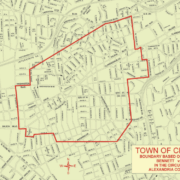In the early 1920s, Arlington was changing fast. Once a rural county of farms, brickyards, and small crossroads villages, it was now a growing suburban community linked to Washington, D.C., by trolleys and new roads. Clarendon was one of these new neighborhoods, a thriving commercial center surrounded by modest homes and civic groups that wanted better roads, lights, and sanitation.

Town Of Clarendon boundary based on the 1920 court case
In 1920, members of the Clarendon Citizens’ Association petitioned to incorporate as the Town of Clarendon. Supporters argued that a local government could more effectively provide water, sewers, police, and fire protection. At the time, Arlington had only one sheriff, limited infrastructure, and relied on citizen groups to fill the gaps. Clarendon’s boosters believed self-governance would bring “greater comfort, happiness, and safety” to their growing community.
Opponents, many of them established county officials, saw things differently. They argued that Clarendon was not separate from the rest of Arlington but part of a larger network of closely connected neighborhoods, including Ballston, Cherrydale, and Fort Myer Heights. Creating a town government, they warned, would divide resources, complicate services, and slow the county’s development.
The case, Bennett v. Garrett, reached the Virginia Supreme Court of Appeals in 1922. The court sided with the county, declaring that Arlington was “one continuous, contiguous, and homogeneous community.” With that decision, the dream of a “Town of Clarendon” ended, but Arlington gained a defining feature. Unlike other counties in Virginia, it would have no incorporated towns.
The ruling helped set the stage for Arlington’s modern government. Freed from the patchwork of small municipalities found elsewhere, Arlington developed as a single, unified community. In 1930, voters adopted a new county manager form of government, another first in Virginia, allowing for professional administration of services across the entire county.
A century later, Bennett v. Garrett stands as a turning point in Arlington’s civic history. What began as a neighborhood’s attempt at self-governance ended up creating a stronger, more cohesive county. The decision shaped Arlington’s identity as one community: diverse, interconnected, and continually redefining what it means to be “Arlington.”
Adapted from Sean Denniston, “Bennett v. Garrett, 1922: When Arlington Became Arlington,” Arlington Historical Magazine (Vol. 15, No. 1), 2022.


